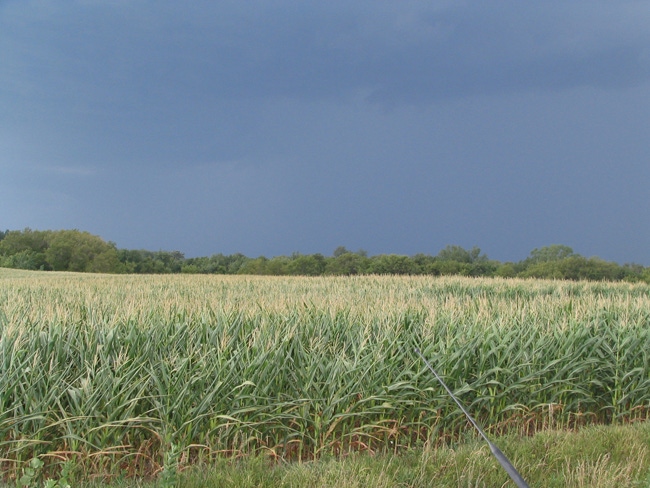August 20, 2012

Producers are asking Fabian Fernández, a University of Illinois assistant professor of crop sciences, about nitrogen rate adjustments for the 2013 corn crop.
He said that, in areas where corn yields were somewhat reduced but overall production practices were normal, no changes to regular practices should be needed for next year’s crop. The Corn N Rate Calculator (http://extension.agron.iastate.edu/soilfertility/nrate.aspx) can be used to calculate the maximum return to nitrogen (MRTN) or profitable nitrogen rate range. For corn following soybean, even for fields with little or no yield, no changes to nitrogen-management decisions should be needed because soybeans do not leave excess nitrogen in the soil.
As a general rule, corn following soybean needs less nitrogen because the quantity and quality of the soybean residue reduces the amount of immobilization and increases the amount of nitrogen mineralization from crop residue and the soil. The Corn N Rate Calculator adjusts for this, showing that, compared to corn following corn, nitrogen rate for corn following soybean for the north, central, and south regions of Illinois can be reduced by approximately 50, 30, and 20 lbs. of nitrogen per acre, respectively.
Decision making is more complicated for fields in which the drought severely affected the corn crop and the amount of nitrogen taken up was reduced. Probably, large amounts of unused nitrate-N are left in these fields. The problem is to determine how much of that nitrate is likely to be available next year.
Fernández said that, while there are no sure-fire methods, it is possible to estimate this amount. The indirect method is by determining how much nitrogen was removed in grain; the direct method is to measure soil nitrate-N (NO3-N) levels.
On average, a bushel of corn removes 0.66 lbs. of nitrogen. To estimate the amount of remaining nitrogen, this removal rate is multiplied by the number of bushels produced per acre and subtracted from the amount of nitrogen applied per acre.
Not all that nitrogen will be plant-available in the next growing season. When nitrogen-loss potential is low (normal precipitation or drier conditions between harvest and next spring), 50% of the remaining nitrogen should be available for the 2013 crop.
For example, if a field received 180 lbs. of nitrogen per acre and yielded only 70 bu. per acre, the remaining nitrogen is 180 minus 46 (multiply the 70 bu. times 0.66 to estimate the amount of nitrogen in the grain), which equals 134 lbs. of nitrogen per acre. When the difference is multiplied by 0.5 (50% availability), the result is 67 lbs. of nitrogen per acre to be subtracted from next year’s nitrogen rate.
“The direct measurement using soil nitrate-N levels is, in my opinion, more reliable than the indirect measurement,” Fernández said. “However, there is still a lot of uncertainty in the estimation because nitrogen availability for the 2013 crop will be largely a function of how much nitrogen-loss potential exists between fall and spring.”
“To obtain a reliable measurement of nitrate-N, collect at least a 12-core composite from representative portions of the field, and at different positions with respect to the crop-row, to a depth of 2 to 3 ft.,” Fernández explained. “Keep each foot of sampling depth as a separate sample. The 2-foot depth should be adequate where little nitrate movement is expected, while the 3-ft. depth is most appropriate for quantifying nitrate-N in fields where rain might have moved the nutrient deeper in the profile.”
In any given year, there is nitrate present in the soil at the end of the growing season. Research has shown that for a 2-ft. sample, only the amount above 40 lbs. of nitrate-N per acre should be subtracted from the application rate.
Due to the uncertainty on how much carryover nitrogen will be present for the 2013 crop, the best way to adjust nitrogen rates may be to collect soil samples in the spring to adjust pre-plant or sidedress rates. This approach implies that nitrogen applications are done in the spring.
As with fall sampling, levels can vary across a field. To obtain a reliable measurement, use a sampling strategy that represents the field. “In normal years, a 1-ft. sample is recommended for spring samples, but with the present conditions, I would recommend that a 2-ft. sample be obtained to quantify nitrate-N in the lower profile,” Fernández advised.
Another approach that can be used to adjust nitrogen rates when the amount of carryover nitrogen is difficult to estimate is to choose the lower end of the profitable nitrogen-rate range in the Corn N Rate Calculator.
Finally, producers have asked Fernández about using the end-of-season lower corn stalk nitrate test to determine nitrogen rate adjustments for next year. “I do not recommend using this test. The values are likely to be artificially high because of the dry conditions that reduced plant growth and grain production,” said Fernández.
You May Also Like




